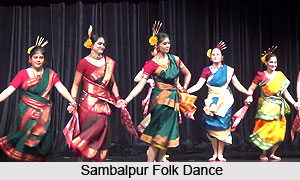 Culture is an inseparable part of the identity of the people of Sambalpur district. The language, dance, songs and festivals everything is intensely linked with the cultural heritage of this district in Orissa. Language is a distinctive feature of the people belonging here. There are two language group, Mundari language group and the Dravidian language group. Dance forms of this district are mostly connected with a function or the worship of a deity. Music is also an indispensable part of the culture of the people here. Sital sashti, nuakhai and puajiuntia are among the most popular festivals celebrated here. Sambalpuri sarees have gained nationwide recognition for their fine texture and beauty.
Culture is an inseparable part of the identity of the people of Sambalpur district. The language, dance, songs and festivals everything is intensely linked with the cultural heritage of this district in Orissa. Language is a distinctive feature of the people belonging here. There are two language group, Mundari language group and the Dravidian language group. Dance forms of this district are mostly connected with a function or the worship of a deity. Music is also an indispensable part of the culture of the people here. Sital sashti, nuakhai and puajiuntia are among the most popular festivals celebrated here. Sambalpuri sarees have gained nationwide recognition for their fine texture and beauty.
People of Sambalpur district mostly enjoy colourful folk dances. The community dances are connected with the worship of a deity. Dhalkhai dance is performed by young girls of Binjhals, Soura and Mirdha tribes during Dussehra, Bhaijiuntia and other festive occasions. The young girls stand in a line or in a semicircular pattern singing songs known as Dalkhai songs. Karma is the most colourful dance of Sambalpur district. It is a tribal dance in honour of "Karam Sani", the deity who grants children. In the beginning the dancers enter the dancing arena in two rows. The drummers and the singers accompany with rhythmic steps. Humo and Bauli are the two playful dances performed by young and unmarried girls on special occasions. The stepping and movements of the dance are very slow. Koisabadi dance is prevalent among the Gond and the Bhuyan tribes. Male dancers take part, holding a two feet long stick. The songs are mainly based on the immortal love story of Radha and Lord Krishna.
The Folk instruments which are in vogue in Sambalpur district region are Dhole, Madal, Nishan, Tasa, Pakhoj, Bansi, Bir-Kahali, Gini, Ektara, Muhuri, Ghulgula, Ghunguru, Jhanj etc. Dhole is an age old instrument of Folk Music. The Dhole of Sambalpur is to some extent different in its making and use. Made from the trunk of a tree, the sides of the Dhole are of same size. Sambalpur dhole can be used for any type of Sambalpuri Folk Song. The Sambalpuri Madal is dissimilar from that of all other parts of India. The Madal is made out of fired clay and is shaped like a cylinder. Madal is a drum which is used in slower rhythms. Most of the dance less songs is accomplished with the Madal. Nishan is made out of iron sheets. The sound emitted by the Nishan is heart-throbbing. This is mostly used in worship of Goddess Kali or Goddess Durga and in the battle field.
Festivals of Sambalpur help to illustrate the vibrant culture of the place. Sital Sasthi is the Marriage Ceremony of Lord Shiva with Parvati. The festival is observed in the month of June with pomp and ceremony at Sambalpur district and is extended for a week. Pilgrims from the neighbouring districts and States of Madhya Pradesh and Bihar also take part in the festival. Lakhs of people gather together in this week long festival. Nuakhai is the most important social festival of this district. Generally it takes place during the month of August and September. The first grains of the paddy crop, cooked into various dishes are offered to the deities. Thereafter the eldest member of the family distributes new rice to the junior members of the family. It is a community festival celebrated by every Hindu family. Bhaijiuntia festival is celebrated on the Mahastami Day of Durga Puja. It is a total fasting undertaken by women for the whole day and night to seek Goddess Durga`s blessing for the long life of their brothers. The Puajiuntia festival is observed by mothers to invoke the grace of Lord Dutibahana for the long life and prosperity of their sons. Others religious festivals which are observed include Shiva Ratri, Dola Yatra, Durga Puja, Janmastami, Diwali, Ganesh Puja and Saraswati Puja.
Festivals, music and dance contribute to the richness of the culture of Sambalpur district. They reflect the age old tradition and the glorious past of the people of Sambalpur district.






